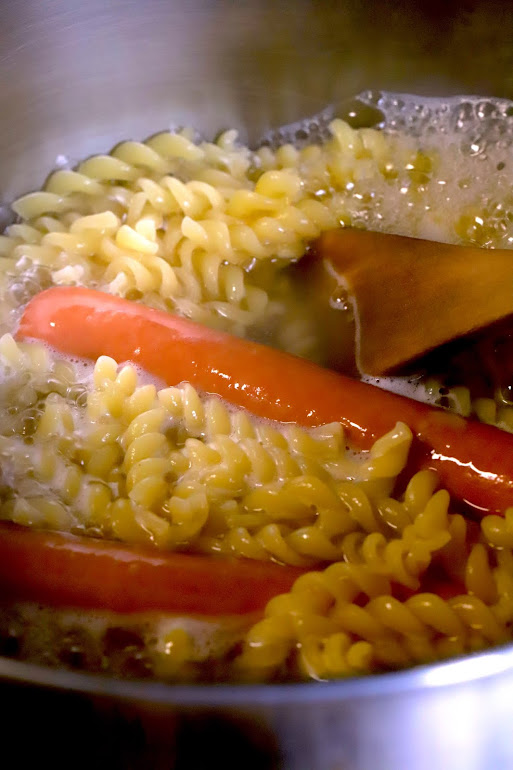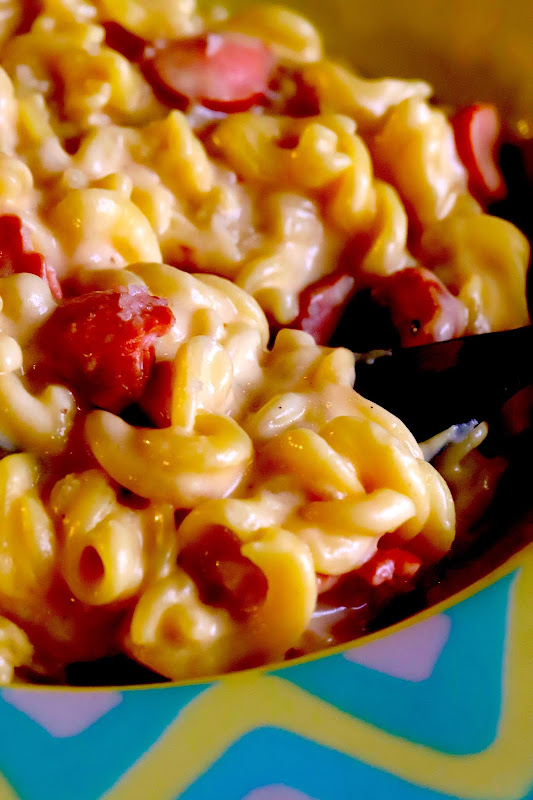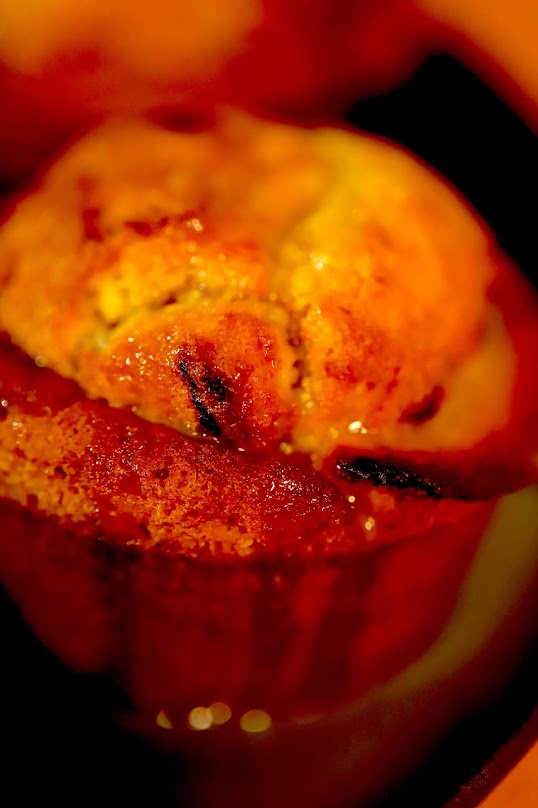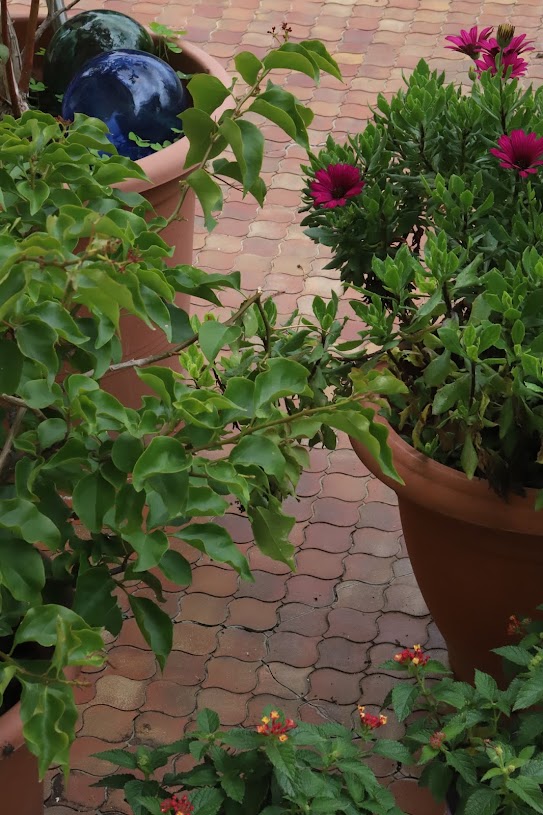Souped-up Garden will be taking a holiday hiatus until the first Thursday in January. Be especially good to yourself and your loved ones as this super-sized disaster year comes to an end. In France, if the vaccination schedule happens as presently planned, I will get a Covid vaccine by the end of February and The Calm One most likely by Spring. Here's hoping the global situation improves through time.
cooking with garden-fresh ingredients grown in an intensive southwest France urban potager; writing book reviews; traveling around & about, mostly in France; taking photographs and making art of it all
Thursday 10 December 2020
Thursday 3 December 2020
Stovetop Macaroni And Cheese, The Evaporated Milk Version With Saucisses de Strasbourg
- Evaporated (NOT condensed which is sweetened) milk, 410 g (400 ml)
- Cheddar, 227 g, freshly grated (packaged grated cheese has starch added to prevent sticking, causing the clumping when macaroni and cheese cools defeating the purpose for going the evaporated milk route.
- Pasta, (in my case, torti), 227 g
- Saucisses de Strausberg or frankfurters, 2-3
- For more oomph, add a large pinch of chili powder to the grated cheese
Thursday 26 November 2020
Book Review / Good And Mad: The Revolutionary Power Of Women's Anger by Rebecca Traister
In the popular imagination, feminism has since its inception been on the verge of collapse, thanks to the intensity of its very real internal conflicts: divisions over race, class, sexuality, and generational difference, not to mention the flare-ups of personal jealousies and combative power plays. These rifts have often been serious and damaging. But they have not set the women's movement apart from any other social justice movement, from the civil rights or Black Power or immigration or gay rights or the New Left or socialist movements, all of which at times been riven by generational, racial, gendered, and class divides, by homophobia, strategic differences, and personal feuds, To some degree, this is the nature of mass activism.
 |
| The author participating at a Bay Area Book Festival |
 |
| Ms Traister guesting on The Late Show with Stephen Colbert |
White women and black men both want what white men have--white women want to have corporate power and black men want to be patriarchs. Black women a) know we're never going to get that and b) don't want that. We don't want to wield corporate power and we don't want to oppress people. That's why I look to black women as the political future.
Ms Traister admits though expressing anger and channeling it into action is effective and emboldening, it is also demanding on relationships and families which was born out during the second feminism wave in the 1960s of which I can personally confirm because that's when I was a young woman. Additionally, if being angry will cost you your livilihood among other supports, this approach doesn't align with everybody who is focused on the arc of progressive change. Regardless, Good and Mad inspires, upskills, and empowers.
 |
| Childhood photo of the author: girl power and some! |
À la prochaine!
Book review / The Golden Thread : How Fabric Changed History by Kassia St Clair
Book review / Lolly Willowes by Sylvia Warner Townsend
Book Review / Against Empathy by Paul Bloom
Book Review / The Tulip by Anna Pavord
Book Review / The Asshole Survival Guide: How to Deal with People Who Treat You Like Dirt by Robert I. Sutton
Book Review / Florike Egmond's An Eye For Detail: Images of Plants and Animals in Art and Science, 1500-1630
Book Review / Hot Bread Kitchen Cookbook: Artisanal
Baking From Around The World by Jessamyn Waldman
Rodriguez with Julia Turshen
Book Review/The Confidence Game: The Psychology Of The Con And Why We Fall For It Every Time By Maria Konnikova
Book Review / The Faith of a Writer: Life, Craft, Art by Joyce Carol Oates
Thursday 19 November 2020
Whole Wheat Muffins Marbled With Ginger Orange Raisin Puree & Topped With Orange Icing
Several weeks ago, I posted about preserving a huge quantity of raisins close to their due date by making a puree. A small batch was done separately, one spiced with ginger and enlivened with orange juice which I envisoned would eventually marble whole wheat muffins. The vision has been realised and here they are! And they are beyond fabulous, fluffy, rich with egg, butter, and milk, sweetened with maple sugar and the oh so tasty ginger orange raisin puree, not to mention the extra oomph of orange icing.
Ingredients- Flour, whole wheat, 240 g (2 American 8 fluid oz cups)
- Sugar, 100 g ( 1/2 American 8 fluid oz cup/8 T)
- Sugar, brown, (1/2 American 8 fluid oz cup/8T) or in my case stir in 1.5 tsp of maple syrup into white sugar
- Baking soda, 1 tsp
- Egg, l
- Vanilla extract, 1/4 tsp
- Milk, whole, 1 American 8 fluid oz cup/16 T)
- Orange ginger raisin puree, 4 T (recipe is here)
- Orange juice and icing sugar depending on the amount and consistency of the finished icing (I use 3 T of juice to about 9 T of confectioner's sugar)
Preheat oven to 400 degrees F. Liberally brush a 12 muffin tin pan with butter, making sure each well is well doused along with a bit just outside their perimeters.
With a wooden skewer inserted right to the bottom of a well, swirl the batter, Turn the pan a quarter, and repeat.
À la prochaine!
Thursday 12 November 2020
Heat Pump Installation
My most vivid memory standing out on that day full of disruption and commotion which also was the second day of the new lockdown was The Calm One trying to find his mask before he sprinted down the hallway leading to the bathroom from which one of the two workers, both Moldavians who live in Paris, the epicentre of the Pandemic, had cried out while handling a major leak from an ancient toilet tank fastened high up on the wall caused by certain pipes just removed in the sous-sol. Before The Calm One could locate his mask, the installer called out again, and The Calm One flashed out of sight. Soooooooo, there were two unmasked people, strangers to each other, in a small, unventilated space. I cracked open the bathroom door and dangled the city-issued blue jobbie inside, robotically uttering mask, mask, mask, mask, mask, until it was grabbed. In three days time, fourteen days, the recommended time for quarantine if one suspects exposure, will have lapsed. Despite not having any covid symptoms as of yet, our oximeter is never that far away. The workers arrived masked, but soon discarded them. They mostly worked in ventilated spaces like outside and the sous-sol with its front and back doors opened, but still. The two men did a fabulous job in about eight hours. When first staring at the tangled mess of dusty pipes covered in ghostly, insulation strips dangling from our thirty-five-year old gas system that was in place when we moved here ten years ago, a long, tortured series of ooh la las came from the installers. They agreed not to place the outside unit on the side of the house closest to a neighbour as was originally planned because it makes a noise like a loud fan along with the air getting pretty blown about from time to time. However, the change in plans meant more work for them because they had to drill through two rooms to get to the side farthest away from other houses.
The jumbled mass of pipes/valves were replaced. The old boiler and water heater were removed. We were told that our old gas system was way more powerful than needed, spewing out more gunk than was even necessary because all those decades ago gas was cheap.
The spanking new HUGE water heater was put in a corner.
To the left of that went an evaporator, and to left of that . . .
. . . a compressor that is connected to . . .
. . . to the outdoor double fan condenser in the east garden, essentially a reverse refrigerator. A refrigerant runs throught all parts of this system. Our upstairs which is where we live (our home is a pavillon sur sous-sol, a common abode in France) is heated via the heat pump set-up through existing water radiators. This arrangement also heats the water for the kitchen and bathroom. Part of the deal was our getting an induction stovetop to replace our gas cooker which once installed will allow us to cancel our gas service.
A most lovely rosemary of the hedge type had to be hacked down to make room for the outside unit.
The mass of aromatic foliage will be composted eventually.
Fortunately about two months ago I took two rosemary cuttings which have rooted well. Our household will not be sans rosemary!
A very plain, straightforward thermostat was affixed to the centre hallway wall of our upstairs living quarters. My goodness, everything is so much more comfortable, very much like being in a luxury hotel providing tons of almost instant hot water with pronounced pressure along with a stable temperature in all rooms. I am glad that this government subsidised program approved us as participants; acceptance took about four steps spaced over several months. The part of the expense we need to pay is in the form of a loan with a moderate rate of interest which can be paid in full if we wish before the final scheduled payment. Our Total Conversion To Alternative Energy Project which now includes the completed installation of photovoltaic panels (no government subsidy, but an interest free loan) and the heat pump will continue with our getting a storage battery in due course. Following that, if required, we will get more photovoltaic panels. Though our motivation for our grand project at present is to reduce our monthly utility bill, the eventual goal is not only to get off the grid but also to earn income by selling surplus energy back to the sector.
See you next week!
Thursday 5 November 2020
There's A Heat Pump Chez Nous!
With the Pandemic back on the front burner along with my doomscrolling Twitter regarding the American Presidential Election, I have enough focus and time to give just a teaser on the continuation of our total conversion to alternative energy project. We already have had PV panels put on the part of the roof facing south last year, and this past week we did the second stage of this plan with the installation of a heat pump set-up. Out went the gas boiler and gas water heater, and in went this stupendous system. Once we replace our gas cooktop with the induction jobbie the installers left with us, we can cancel our gas service. The next and final step will be the purchase of a storage battery. Following that, if required, we will get more PV panels. Our eventual goal is not only to get off the grid but also to earn income by selling surplus energy back to the sector. Next week I will provide more info and photos regarding the day-long fitting of our new, fabulous, and environmentally friendly arrangement. Until then, here's a photo of the outside exceedingly pretty double fan unit.
See you next week!
Thursday 29 October 2020
Thursday 22 October 2020
Preservation of Produce: Raisin Puree
The other day I finally noticed two, large, long-neglected bags of raisins in our sous-sol cupboard. They were a smidgin away from their due date. Though I been wanting to bake some whole wheat raisin muffins for a while, I figured doing that would use up just a fraction of this dry fruit deluge so what to do with the rest? Fruit puree, whether fresh or made from dried fruits, freezes well.
I made two separate batches of raisin puree. The larger one was covered with water.
To marble either yogurt or muffin/cake batter: Put separate dollops of puree and yogurt/batter in a checkerboard pattern in the first layer. For consequent layers, alternate the dollops, that is, put puree over yogurt/batter, then yogurt/batter over puree until the glass or baking pan is filled. Using a wooden skewer, insert it all the way to the bottom of the glass or pan and working from side to side, twirl the skewer. Turn the glass or pan a quarter turn and repeat the twirling.
Thursday 15 October 2020
View From The Balcony Autumn 2020
Our front balcony entrance brings so much enjoyment, and not only to us but also to Eli the Cat who shows his appreciation for the doormat every chance he gets.
I love leaning over the railing to check out the front garden. The flowering shrubs in the upper right corner of the below photo are two abelia, beloved by bees. When I recently did my afternoon exercise walk around the garden the other day, I got to see a HUGE bee all on his lonesome, probably belonging to the Megachilidae family, thrusting its upper body into one of the tubular flowers.
The balcony wraps itself partially around the eastern side of our home. Access to the balcony from the inside is facilitated by not only the foyer door but also two living-room French doors. Presently asters are the dominant blooms from that perspective.
While on the side balcony if one turns towards the south, the rest of the eastern planting with its ivy-covered wall can be seen as it continues into the back garden. Eli the Cat stands guard at various points along the eastern perimeter, mesmerised by sounds coming from the plants' direction, mostly made by insects and the wind.
Once back on the ground, going around the southeast corner of the house brings you to the south-facing back garden with its patio and ivy-covered pergola. The pergola-facing potting room is in the sous-sol (our home is a pavillon sur sous-sol, that is, the living quarters are on the top floor; downstairs houses the unheated garage, utility/storage room, potting/mud rooms, and cellier). The temperature is now cold enough for all the frost-tender potted plants to spend at least the nights inside the sous-sol, near the potting room's window, including the tuberous begonia which is spending the day on the table under the pergola.
It is still flowering but will start shedding leaves fairly soon, feeding its tuber, hopefully giving us a fifth year of flowers starting in June and going all the way to November.
Thursday 8 October 2020
Photography Series: Indoor Studio on a Rainy Day
It's been raining for a while now, close to two weeks and is looking to continue.
Some days the rain is intermittent, others, just one continual downpour. The day I took these photos belonged to the latter category. The Canon 6D Mark II which I got about three years ago is a marvel. Moi, not so much! This full range model which is known for how it accommodates both the bokeh effect and low-light situations has many a zillion other wondrous features which are maddeningly still beyond my reach. I know there are answers to my specific problems buried somewhere in a class, book, and website, and I do search for it, but mostly am coming up purblind and empty-handed. Though I acknowledge how much I don't know, what I do know is what holds my attention which of course helps to define my developing style. And what draws me is not only the subject matter but also how I access it and how I handle the camera. No tripod. Please! And certainly no photoshop (though I make an exception for Saul Leiter painting on developed prints and would love to get a print for the photo below and paint splashes of various blues and golds, here and there, to emphasise three dimensionality and vibrancy). Double please! Or special lighting. Triple please! Though I do meddle with arrangements from time to time, I look for one already accomplished just by living the rhythm of one's life.
What I do drive myself to distraction is from what angle I will view what I am photographing. I will lie on my side, climb on chairs, put stuff on the floor and stand over it, and walk around the objects—involving at time moving sofas and bookcases—until I am dizzy. Relying on this camera's combo of live view and flip-out screen would save my knees from a lot of creaking, but it would also mean using the forbidden tripod to get steady shooting.
I did move the zebra-patterned lipstick case (it was nearby) into the below shot to create a complementary colour duo of blue and orangey gold.
My addiction of choosing in most photos a macro prime lens for both its close-up capability and its crisp image creates difficulty in achieving depth of field. The surest way to get depth of field is by moving away from your subject which of course would defeat the purpose of a macro lens.
Another significant aspect of what rivets my eye is texture. The black patent leather effect of the cardboard socks box along with the letter X and the shiny red heart on its side contrasts with the softness of the fabric-covered sewing basket.
I often set the camera on the aperture mode which means I get to choose the f-stop. A lower number is correlated with a more opened lens along with more light but with less depth of field and a higher number with a less opened lens along with more depth of field but with less ambient light. The camera's range is from f/2.8 to f/32. I teeter on that technical tightrope with each shot never striding confidently any great distance. The visual conclusion is often that there is either too little light but decent depth of field or adequate light but not enough depth of field.
The below photo and the following one show that depth of field and adequate light is simultaneously possible. It's just I can't count on amalgamating those two features with a sufficient degree of consistency!
My furry model then suddenly decided, as they often do, that he was hungry.
À la prochaine!























































